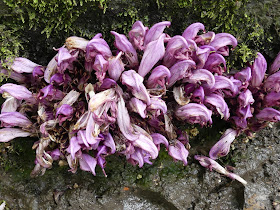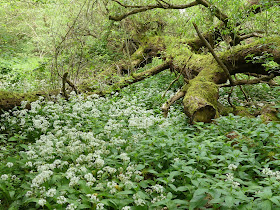A record of wildlife in my garden and various trips to the Warwickshire countryside and occasionally further afield.
Thursday, 17 May 2018
A Woodland Walk
Last Saturday D and I went to Brueton Park, Solihull, in search of Wild Garlic - one of my favourite Spring flowers especially when you find it growing over a large area.
This is the path which leads towards the local nature reserve area of the park already we could smell the garlicky/oniony smell of Wild Garlic.
You can see the River Blythe in the background of this photo.
Horse Chestnut "candles" are in flower and
the first sight of Wild Garlic.
Brueton Park can get very busy with families and dog walkers especially during the weekend but the local nature reserve part of the park is much quieter. The path we were to take through the woods is hard to find unless you know where it is and we didn't see a soul on this part of our walk. I first discovered it about 5 years ago when doing a wildflower survey for Plantlife. I was allocated a square that included Brueton Park and found on an OS map the public footpath which went straight across the square. I try and return every year in May as it is a delightful stroll.
Into the woods and Wild Garlic "paradise".
Wild Garlic (Allium ursinum) has a number of country/local names such as Ramsons, Buckrams, Broad-leaved Garlic, Bear Leek, Bear's Garlic, Gipsy's Onion and Shrinking Jenny. It is edible (although care must be taken that you are not eating the leaves of Lily of the Valley which look similar and are poisonous) and is a relative of chives. It is an indicator of ancient woodland.
The footpath follows the course of the River Blythe.
Purple Toothwort (a parasitic plant that has naturalised in Britain) still growing on the same tree trunk.
Wild Garlic with a few plants of Yellow Archangel - another indicator of ancient woodland.
It was muddy here too!
Fungus
Can anyone confirm the id of the bird that this feather came from please? I have put the photo on Twitter and received a few suggestions but would love confirmation.
The footpath leaves woodland and threads between the River Blythe on one side and a big field on the other. In the past this field has been full of buttercups but only a few were in flower last Saturday.
As you walk along this stretch you can hear the rumble of traffic on the M42 which is not far away.
And so into the next wood which has more open glades and Bluebells mixed in with Wild Garlic.
Blubells (Hyacinthoides non-scripta) also have other country names such as Granfer Griggles, Crowfoot, Crow Flower, Crow's Legs, Blue Trumpets, Bell Bottle, Blue Goggles, Adder Bell, Wood Bell, Ring o'Bells and Wild Hyacinth. Glue was once made from the starchy sap of the bulb and used to attach feathers to arrows. The bulbs also provided starch for Elizabethan ruffs. Bluebell juice was once used to cure snake bites! and the bells of Bluebells chime out at dawn to call fairies back to woodlands (according to folklore!).
We retraced our steps at this point.
We then decided to visit another part of the local nature reserve - Marsh Fields - where I had heard there was a good display of Cowslips.
Hawthorn is now flowering profusely everywhere.
An information board giving details of butterfly species found here - it might be worth returning in the summer.
And finally, we found the Cowslips (Primula veris.)
"And I serve the Fairy Queen
To dew her drops upon the green;
The cowslips tall her pensioners be;
In their gold coats spots you see;
These be rubies, fairy favours:
In those freckles live their savours."
From "A Midsummer Night's Dream" William Shakespeare.
Legend suggests that the Cowslip is the flower of St Peter and the Keys of heaven. On discovering that a duplicate set of his keys had been made and that some souls were entering Heaven via a back door, St Peter was so upset that he dropped his keys which fell to earth. The key shape of the flowers was also once said to have the power to split rocks open to reveal hidden treasure.
Alternative names such as Cowplop, Cooslop and Cowslop, derive from the fact that Cowslips grow well on manured pasture land.
Other country names for the plant include Fairy Cups, Milk-maids, Fairies Flowers, Our Lady's Cushion, Galligaskins, Jackanapes on Horses and Freckled Faces. The flowers were once believed to have magical powers that would restore youth's beauty and bloom! In Medieval times they were used as a medicine to try and cure palsy and paralysis. Cowslip wine is a well-known cure for insomnia.
Centuries ago girls living in the countryside would make cowslip "balls" or posies called Tisty Tosties. They would play a game of catch with the ball singing "Cowslip ball tell me true, who shall I be married to?". The girls would shout the names of unattached local boys and if a person dropped the ball she would marry the boy whose name was last called out.
The Cowslip is the food plant of the Duke of Burgundy butterfly.
D spent ages trying to capture a photo of dandelion seeds floating away!
*D
Grey Squirrel
*D
*D
*D Photos taken by D with the Canon SX50 bridge camera
The rest of the photos were taken by me using the Panasonic Lumix FZ330 bridge camera
Reference: "Discovering the Folklore of Plants" by Margaret Baker - Shire Publications
"Britain's Wild Flowers - a Treasure of Traditions, Superstitions, Remedies and Literature" by Rosamond Richardson - National Trust















































Wild garlic is totally new to me. I would love to try cooking with it. Garlic and onion are absolute staples in this house and there is not a whole lot we cook without those two ingredients. Have you cooked with wild garlic?
ReplyDeleteThe local wild garlic patch here has gone over! Sad, but garlic mustard (a little less pungent) still in bloom
ReplyDeleteDavid Gascoigne - Thank you. I have quite a few recipes for Wild Garlic and keep meaning to try a few but have to admit haven't yet - I am a bit fussy as to where I gather my items if foraging and haven't yet found a place where I would fancy picking some. Am looking into buying some plants for the garden which might solve the problem :)
ReplyDeleteSimon Douglas Thompson - Thank you - both still flowering well here. I could tell it was Garlic mustard growing in the garden woodland area before the flowers appeared just by rubbing the leaves and smelling them :)
What a wonderful walk and how beautiful the wild garlic looks, I don't think I've seen anywhere that has as much growing. I love too your folklore tales about the bluebell and cowslip flowers. We made pesto with some wild garlic leaves recently (but added cashew nuts instead of pine nuts) and it was very tasty. The leaves were selected very carefully and washed well before use - thankfully what Lilly of the Valley we have that hasn't been eaten by slugs is on the opposite side of the garden:)
ReplyDeleteRosie - Thanks so much. The Rosamond Richardson book is worth looking out for - I saw it for sale yesterday in the NT Shop at Baddesley. The other book I bought at Osborne House on the Isle of Wight.
ReplyDeleteI would definitely eat wild garlic from the garden - your pesto sounds delicious. My son is very keen on using some in recipes. Lily of the Valley has had a good year in our garden this Spring - one small raised bed is full of it.
Very nice to have your own 'secret' path away from everyone else, it must be very peaceful! I love smelling the wild garlic at the moment and with all the other flowers it's making everywhere so nice to walk. Lovely photos :)
ReplyDeletePam - Thank you. The walk is amazing and unbelievably less than a mile from Solihull Town Centre. Car Park was jammed full - had to park on the road and yet the lnr part was deserted. What people miss!
ReplyDeleteAlthough I'm an autumn person, few things lift my spirits than a walk along a British forest footpath, or hedgerows, lined with all the beauty of springtime flowers. Why, just today I came across a forest path and wished I'd had my camera along. I love wild garlic, and have some seeds in hopes of growing some in my garden to have it close to the kitchen!
ReplyDeleteLovely photos Caroline. Is the feather from a Sparrowhawk ?
ReplyDeleteI am chasing my tail here and need to catch upon your recent posts. This is a wonderful one. The photos of the Ramsons brought back so many memories. I have them growing here in two spots in the garden, but remember them best from finding out about them when sitting in a huge patch in the Purbecks in Dorset! Stank of Garlci all day and not too welcome on the bus going home!
ReplyDeleteThen there was a lovely Edward Thomas walk we did from Steep, up in the Hangars. Oh it was beautiful - and just like your photos.
Thank you for sharing and all the wonderful folk lore too.
Deborah O'Brien - Thanks so much. I think May and October are my favourite months of the year. Thank you for the tip re: the seeds as I would love some for the garden so will look into the seed idea.
ReplyDeleteDean Stables - Thanks so much. Yes, we thought Sparrowhawk was the most likely too - so thanks especially for the same suggestion :)
Bovey Belle - Thanks very much. It is so hard at times to keep up with blogs especially if you miss a few days or after a holiday a week!! Envious of your two spots in the garden - yes it does smell a trifle!! :)
The Edward Thomas walk sounds wonderful - I do love his poems. So pleased the post brought back memories of Dorset and the Hangars for you.
What a lovely place with so much to discover, the flower from the Horse Chestnut is beautiful , often missed as it can be so high up. Did not know about Purple Toothwort great colour. I just love Cow Parsley but the field of Cowslips is a stunning sight.
ReplyDeleteWonderful set of photos.
Amanda xx
Amanda Peters - Thanks so much. Luckily these Horse Chestnut flowers were quite low :) Purple Toothwort is an interesting plant - especially now it has naturalised. Always see it there in exactly the same place! :)
ReplyDelete